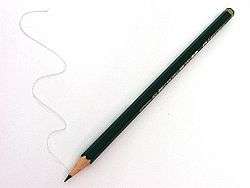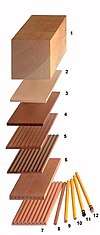Graphite pencil
Graphite or lead pencil is a writing or drawing tool in which a thin graphite core is embedded in a shell of other material. The pencil shell is mostly wooden, but can be made of plastic or recycled paper.

History
A large deposit of graphite was discovered in 1565 on the approach to Grey Knotts from the hamlet of Seathwaite in Borrowdale parish, Cumbria, England.[1][2][3][4] This particular deposit of graphite was extremely pure and solid, and it could easily be sawn into sticks. It remains the only large-scale deposit of graphite ever found in this solid form.[5] Chemistry was in its infancy and the substance was thought to be a form of lead. Consequently, it was called plumbago (Latin for "lead ore").[6][7] Because the pencil core is still referred to as "lead", or a "lead", many people have the misconception that the graphite in the pencil is lead,[8] and the black core of pencils is still referred to as lead, even though it never contained the element lead.[9][10][11][12][13][14] The words for pencil in German (Bleistift), Irish (peann luaidhe), Arabic (قلم رصاص qalam raṣāṣ), and some other languages literally mean lead pen.
The value of graphite would soon be realised to be enormous, mainly because it could be used to line the moulds for cannonballs; the mines were taken over by the Crown and were guarded. When sufficient stores of graphite had been accumulated, the mines were flooded to prevent theft until more was required.
Graphite sticks were initially wrapped in string or sheepskin for stability. England would enjoy a monopoly on the production of pencils until a method of reconstituting the graphite powder was found in 1662 in Italy. However, the distinctively square English pencils continued to be made with sticks cut from natural graphite into the 1860s. The town of Keswick, near the original findings of block graphite, still manufactures pencils, the factory also being the location of the Cumberland Pencil Museum.[15]
Production

Production technology has changed little over the past 120 years. Only standards and mechanisms for the manufacture of rods and wooden halves were improved. The main components in the manufacture of rods - purified graphite powder and kaolin (a clay binder). Hardness depends on the ratio of their particles. The more graphite - the softer the rod. The hardest pencil contains about 20% graphite, the softest one up to 90%[16]. The 1:1 ratio roughly corresponds to the 3H hardness[17]. The sequence of operations for the manufacture of graphite rods:
References
- Martin and Jean Norgate, Geography Department, Portsmouth University (2008). "Old Cumbria Gazetteer, black lead mine, Seathwaite". Archived from the original on 7 January 2009. Retrieved 19 May 2008.CS1 maint: multiple names: authors list (link)
- Alfred Wainwright (2005). A Pictorial Guide to the Lakeland Fells, Western Fells. ISBN 978-0-7112-2460-5.
- "Graphite from the Plumbago Mine, Borrowdale, England". Department of Physics at Michigan Technological University. Archived from the original on 14 March 2008. Retrieved 27 March 2008.
- Petroski, 1990, pp. 168, 358
- "Lakeland's Mining Heritage". cumbria-industries.org.uk. Archived from the original on 15 March 2008. Retrieved 27 March 2008.
- "Definition of Plumbago". Answers.com. Archived from the original on 13 August 2007. Retrieved 21 April 2007.
- "Definition of Plumbago". Thefreedictionary.com. Retrieved 21 April 2007.
- The big book of questions and answers, Publications International LTD, (1989), p.189, ISBN 0-88176-670-4
- "Why is lead used in pencils even though lead is poisonous?". Science Questions with Surprising Answers. Archived from the original on 5 March 2016. Retrieved 5 October 2015.
- Bennett, Howard J. (26 November 2014). "Ever wondered about the lead in pencils?". The Washington Post. ISSN 0190-8286. Archived from the original on 6 November 2015. Retrieved 5 October 2015.
- "Pencil swallowing: MedlinePlus Medical Encyclopedia". www.nlm.nih.gov. Archived from the original on 6 October 2015. Retrieved 5 October 2015.
- "graphite pencils | The Weekend Historian". umeshmadan.wordpress.com. Archived from the original on 7 October 2015. Retrieved 5 October 2015.
- "Origins of the Pencil (Circa 1500 – 1565) : HistoryofInformation.com". www.historyofinformation.com. Retrieved 2016-10-29.
- "Lead Facts - Uses, Properties, Element Pb, Plumbing, Pipes, Weights". www.sciencekids.co.nz. Archived from the original on 30 October 2016. Retrieved 2016-10-29.
- "Keswick Pencil Museum". Pencilmuseum.co.uk. Archived from the original on 3 August 2009. Retrieved 23 July 2009.
- Ryschkewitsch 1926, p. 777.
- "H und B". Retrieved 2019-09-19. (in German)
Bibliography
- Petroski, Henry (1990). The Pencil: A History of Design and Circumstance. New York: Alfred A. Knopf. ISBN 978-0-394-57422-6.